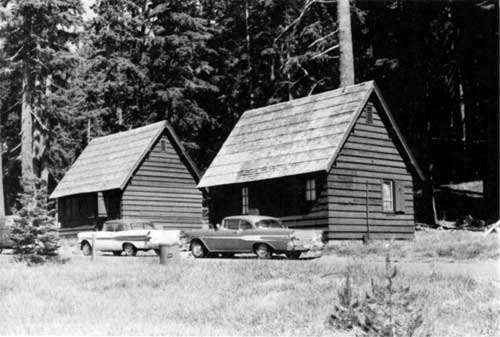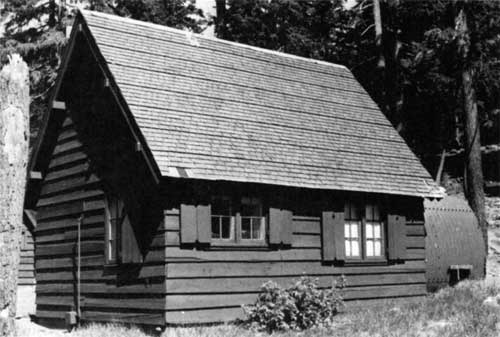By 1945 the hospital building was practically finished. The first floor was to serve as the hospital unit, with a physician’s office and treatment rooms. The second floor would be the physician’s living quarters. [66] This structure was still incomplete in 1948, and Superintendent Ernest Leavitt was recommending that the first floor be converted to living space due to a critical housing shortage at the park. Changed conditions in park operation’s made the completion of the structure as a hospital building of doubtful value. Now, only a first-aid room was considered necessary for emergency use and for the accommodation of patients awaiting transportation to hospitals at Medford or Klamath Falls. [67] The infirmary is now used as seasonal quarters.
The opening of the Willamette Highway on July 17, 1940, brought an influx of visitors to the park via the north entrance, causing congestion, delays, and confusion. Originally, tents had been used as checking stations. A temporary checking kiosk was constructed and began operations in July 1940, which helped ease the problem. A similar station was erected at the east entrance road to speed up car checking. It was planned eventually to make these stations permanent. [68] In 1946 a request was made for temporary checking kiosks at the south and west entrances of the park. [69] Work on these started in June 1947.
Also in 1947 water was piped in to the Community House on the rim, a hot water heater and sink were installed, and a large wood-burning air heater was set up so that the structure could be used by skiers as a warming hut, for ski waxing, and as a lunch room. A lunch wagon was scheduled to run to the park on weekends and holidays during the winter. [70]
In 1949 the Crater Lake School Association was organized to handle the education of three school-age children and five pre-schoolers. The commissioner’s office in the administration building was to be used as the schoolroom. In this same year, four comfort stations were built, at Kerr Notch and Lost Creek campgrounds. A new north entrance checking station kiosk was built to replace the one built in 1941 and wrecked in a accident the previous fall. [71] It was moved on site July 1. This was considered an important station because it handled a large number of incoming visitors as well as all northbound vehicles entering from the south and west. In 1950 rehabilitation work on the mess hall at park headquarters was continuing. Sills, floor joists, and the lower end of the studs were replaced in the dining room and kitchen and sub-floors relaid. Changes in wiring and in the sewer and water systems were also being made. [72]
In 1951 eight Sleepy Hollow cabins were rebuilt and four remodeled. After several years of limited budget, the NPS in the mid-1950s finally obtained sufficient funding to allow the resumption of park development on a significant scale. As the demand for facilities bloomed, a flurry of activity began during the Mission 66 program, a long-range plan to update development and management of the national parks and enhance visitor enjoyment. Projects were scheduled for completion upon the Golden Anniversary of the Service. The Mission-66 building program of the mid-1950s reflected the utilitarian outlook that had started emerging among park designers just before the war. Occasionally when a structure was to be added to an area where pre-war rustic structures existed, an attempt was made to erect new rustic buildings. Generally the effort was unsuccessful, due to problems in finding skilled labor and because of the high cost. It became apparent that implementation of the rustic architecture philosophy was feasible only within a park system of limited size and scope. New employee housing at Crater Lake, comprising three modern two-story duplexes, was a result of the Mission-66 program, as were a new community school, finished in 1964, and a new shop and equipment storage building, constructed during 1963-64.
Illustration 57. Cabins in Sleepy Hollow residential area.
***previous*** — ***next***



